By nearly every measure, the first Ranked Choice Voting election in our nation’s largest city was a resounding success, with the Washington Post editorial board calling on the expansion of RCV in more places.
Many of the promises of RCV came to fruition: The election was more diverse, inclusive and representative; turnout was up; voters enthusiastically embraced the new system; and the winning candidates earned broad voter support.
Transformational change: More women and people of color ran and won in the NYC primary election using Ranked Choice Voting
The RCV primary will result in one of the most diverse councils in the city’s history — with historic wins for women and candidates of color. More women and people of color ran and won, including mayoral nominee Eric Adams.
Given the dominance of the Democratic Party in NYC, the primary election results will most likely prevail in the November general election, and it is expected that women will represent a majority of the City Council for the first time in history. The current City Council has 14 women. After the RCV primary and with the anticipated results in November, women are expected to outnumber men on the Council, likely holding at least 29 of the 51 seats, the highest number of women on the council ever. Of those seats, 26 are women of color. In an interview with the Gothamist, NOW-NYC Executive Director Sonia Ossorio noted, “The surge in women of color running for office and going on to win is historic. This is transformational change at its core.”
Mayoral candidate Maya Wiley said in a post-election OpEd in the Washington Post that “alarm bells over RCV miss the point. Making it easier to vote, educating voters and encouraging a new pipeline of diverse candidates who are not beholden to powerful interests are the tools that will guarantee our democracy.”
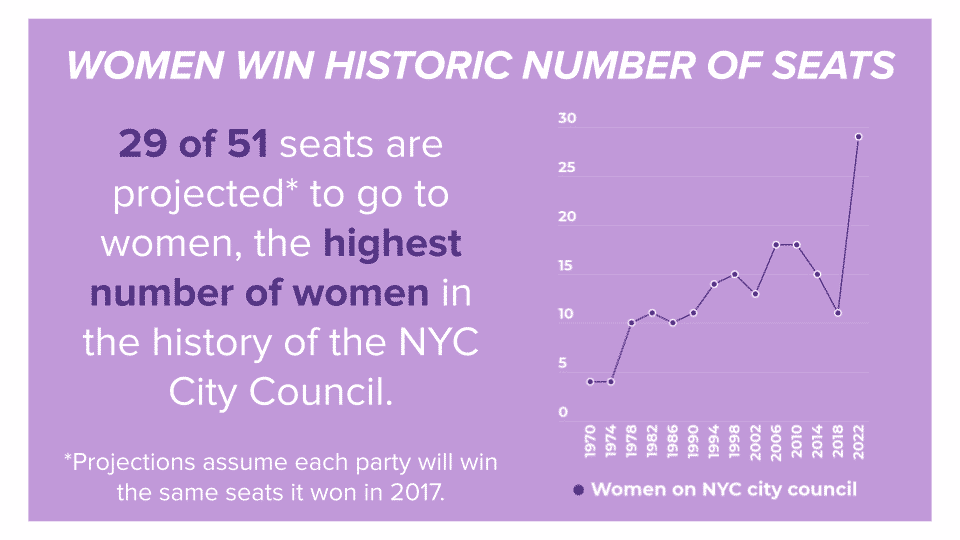
RCV allows women and candidates from diverse communities and backgrounds to run without fear that they will split or siphon votes from the same community or base of support, encouraging more diverse candidates to run and win. The NYC RCV election illustrated this benefit. In the mayor’s race, the final top four candidates were all women or people of color. Overall, 34 primary council winners identify as people of color, an increase from the current 26 on Council and more closely resembles the city’s diverse demographics. RCV encourages more candidates to run, more competitive elections, and more representative results. For a great summary of the benefits of RCV, see Amanda Litman and David Daley’s piece in Salon: Sorry, Haters: Ranked-choice Voting Produced The Most Diverse City Council In NYC History.
In short, this election demonstrated RCV’s promise of more diverse, inclusive and representative elections. It can remove structural barriers to participation and should be viewed as a reform that can accelerate diverse and equitable representation. After the general election, NYC can look forward to a city government that more fully represents its diverse electorate.
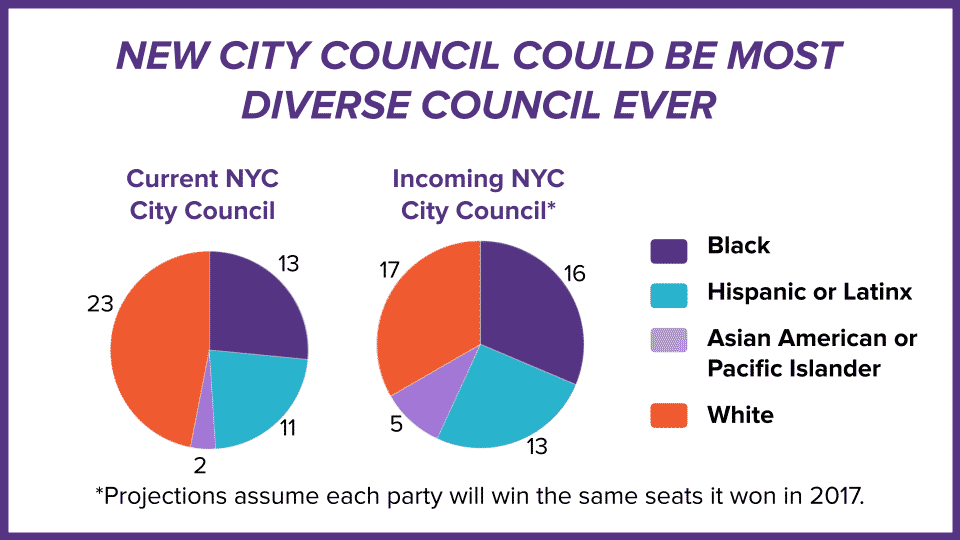
NYC Voters embraced RCV
Turnout was up, and NYC voters enthusiastically embraced RCV. Despite claims that RCV was confusing or could deter turnout, New Yorkers showed up at the polls and voted in greater numbers. More than 930,000 people voted in the Democratic primary, as compared to the 700,000 who voted in the last competitive mayoral race in 2013. In fact, turnout was the highest it has been in over 30 years (see graphic below). Turnout was not only up in the mayor’s race; more voters took part in down ballot races as well. While multiple factors can affect turnout, the election rejects the tired argument that RCV deters turnout, and to the contrary, shows that it may in fact increase turnout.
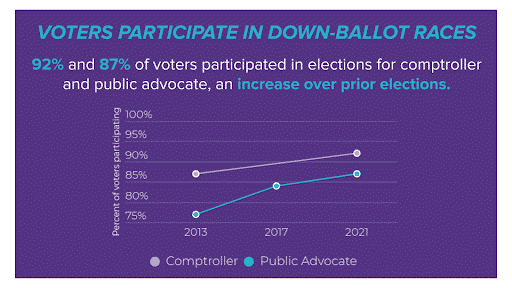
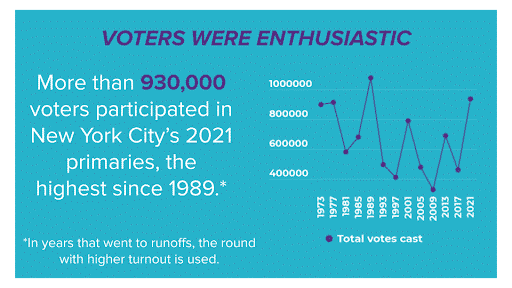
And the voters loved it! Contrary to naysayers that alleged it would be too confusing for voters, an Edison Research exit poll showed that 95 percent of voters found the ballot “simple to complete,” and 83 percent of voters ranked at least two candidates. The poll found that 77 percent want to use ranked-choice voting in future elections, an increase from the more than 73 percent who voted to implement it back in 2019. See full results of the Edison poll here.
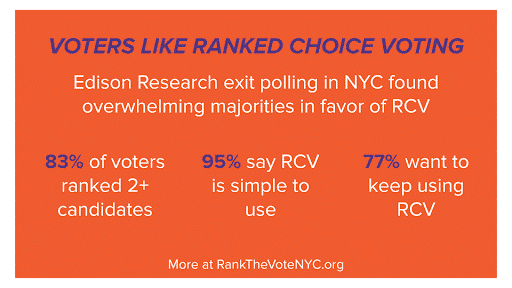
With RCV, second choices matter and winners are broadly supported
Ranked choice produced winners with broad majority support which we saw happen in the rounds of tabulation. Mayoral front runner Eric Adams started with a relatively strong lead but Kathryn Garcia gained more support from second and later choices. Adams nonetheless kept his lead and earned enough second- and third-choice votes to become the winner. In the end, he prevailed as the broadly acceptable choice among a large field of candidates which would have fractured the vote in a traditional election. An important lesson for candidates in future RCV elections is to actively court second choices and make it a core part of their campaign strategy.
Although Adams was ahead in the first round which would have been the end point in a traditional plurality election, he had only earned less than one-third support of the Democractic electorate. Now he can claim a majority victory, without the hassle of an expensive runoff. Moreover, RCV gives us more information about the voters’ true preferences. We know almost half would have preferred Garcia as mayor which could impact how Adams governs going forward — something we would not have known without RCV. And the ranked choice primary system fulfilled one of its most important benefits – producing a winner who is more broadly supported by eliminating candidates on the ideological extremes who have a dedicated but smaller base of support.
In conclusion, the NYC ranked choice primary demonstrated the many benefits of RCV, producing more broadly representative winners that, assuming they win in the general November election, will be more responsive to the interests of the majority in the city and their council districts.
We anticipate similar outcomes in the five cities using RCV this November in the Twin Cities – Minneapolis, St. Paul, St. Louis Park, Bloomington, and Minnetonka. Learn more at rankyourvote.org and please contact Jeanne Massey at jeanne.massey@fairvotemn.org if you have any questions or would like a media interview.

